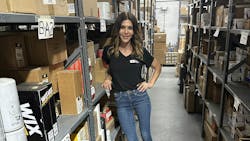How Vehicle Maintenance Program solved a fuel-pump mystery
Key Highlights
- When a large logistics fleet needed a solution to a faulty fuel pump, they went to Vehicle Maintenance Program (VMP)
- To solve the issue, which saw trucks stuck at the roadside when they'd suddenly run out of gas, VMP and their trusted partner designed a new fuel pump with a sealed connection, a new design for the float valve, and upgraded filtration
- Now, VMP is growing based on its success, and workign to create more solutions to fit their customers' needs
When a large logistics company with a medium-duty fleet found that their trucks were stalling on the side of the road due to an empty gas tank, they needed a fix. They even knew the culprit for their woes: a faulty fuel pump for their GM 6.0L gasoline engine, which provided inaccurate readings and had to be replaced every 12-18 months. But while they tried switching to new fuel pump brands, their trucks continued to end up at the roadside, burning time and money for the fleet and straining their personnel. As an organization that had been running sophisticated metrics on their timeliness and efficiency for decades, the situation was untenable.
For more on diagnostic mysteries:
“It was like every day they were getting multiple calls for the same exact issue,” explained Lindi Brooks, president at Vehicle Maintenance Program (VMP), the aftermarket parts supplier that came to the fleet’s rescue. “And it's frustrating when you've gone through all the options available out there already and none of them are solving the problem.”
With OE parts suppliers always offering the “same product that’s always on back order,” the fleet turned to VMP. VMP, a woman-owned business that’s been working since 1988, was determined to solve the fleet’s pain point, seeking a solution that would provide both cost savings and longevity.
Editor’s note: Some confidential, proprietary details have been omitted at VMP’s request.
The fuel pump finding
To begin work on the fleet’s fuel pump problem, VMP joined forces with a trusted partner company, which handles their engineering and design, to analyze the failed components. There, they found that the fuel level sensor’s circuit board wasn’t just housed in the fuel tank, but in the fuel itself, leaving it exposed to particulates. The issue was that while the sensor’s floating arm valve was working properly, contaminants were infiltrating the sensor and completing its circuit, preventing it from accurately depicting fuel levels.
Once they determined the issue, VMP knew that they’d need to reengineer a new component.
“It was the first idea,” Brooks explained. After all, “By the time that the issue came to us, [the fleet had] tested all the competitors. So at the time that we got it, we thought, ‘Okay, what can we do to redesign this pump so it eliminates all of these consistent failure reasons?’”
It was a slow process. First, VMP completed the design within a year, then there was another year or two of fleet testing to finalize the design. During this period, VMP planned out how to handle the engineering, inventory, freight, imports, and more—and, of course, there was plenty of communication between them and the fleet.
“We spoke with them at length,” Brooks recalled, working tirelessly to address every fix request the fleet submitted.
But all of that work was worth it when the reengineered pump was finally approved. In basic terms, the solution involved taking the electrical connection out of the fuel and sealing it, instead using a magnetic system for the float valve and to complete the sensor circuit. Additionally, the new design included upgraded filtration and a carbon commutator to improve the pump’s life.
“When we finally got it, I remember reading the email [that it was] approved, and I think I jumped up and down,” Brooks laughed. “It was put to rest. It took a long time to get there, but [the fleet was] very pleased.
“And, of course, they were moving on to the next project [with us], because that's only one of hundreds of 1000s of parts that are being used,” she noted
VMP all in the family
But serving fleets is nothing new to Brooks. Her grandfather owned several automotive stores, and Brooks’s mother founded VMP in 1988, starting with bidding into transits and other state and local government work.
“I basically grew up in the world of automotive parts,” Brooks said. And although “[My mother] never really worked for my grandfather, she was involved because that was our dinner conversation.”
All this laid the groundwork for Lindi to join the company in 2001, bringing her drive to help fleets along with her.
“By nature, I am a very solution-focused person,” she explained. “So when I applied that concept to VMP, it evolved from a basic distribution model to a ‘total solution’ model. That’s the way I run the company: solution focused.”
And it’s this focus on solutions that helped VMP stand out.
“I found that what differentiates VMP from a Grainger, minus the size of the company, is that we want to provide a solution tailored to our customer,” Brooks added. “We want to provide them with something that is within their parameters, not within our parameters.”
Going forward, VMP is continuing to focus on their customers’ needs, using their experience to engineer more than fuel pumps.
“We have [done] so much testing and high-level engineering that that expertise has rolled out into a number of other products,” Brooks concluded. “I can say that with our relationships and our ability to provide these solutions for fuel pumps and a variety of other parts, that we have grown the business significantly.”
About the Author

Alex Keenan
Alex Keenan is an Associate Editor for Fleet Maintenance magazine. She has written on a variety of topics for the past several years and recently joined the transportation industry, reviewing content covering technician challenges and breaking industry news. She holds a bachelor's degree in English from Colorado State University in Fort Collins, Colorado.

